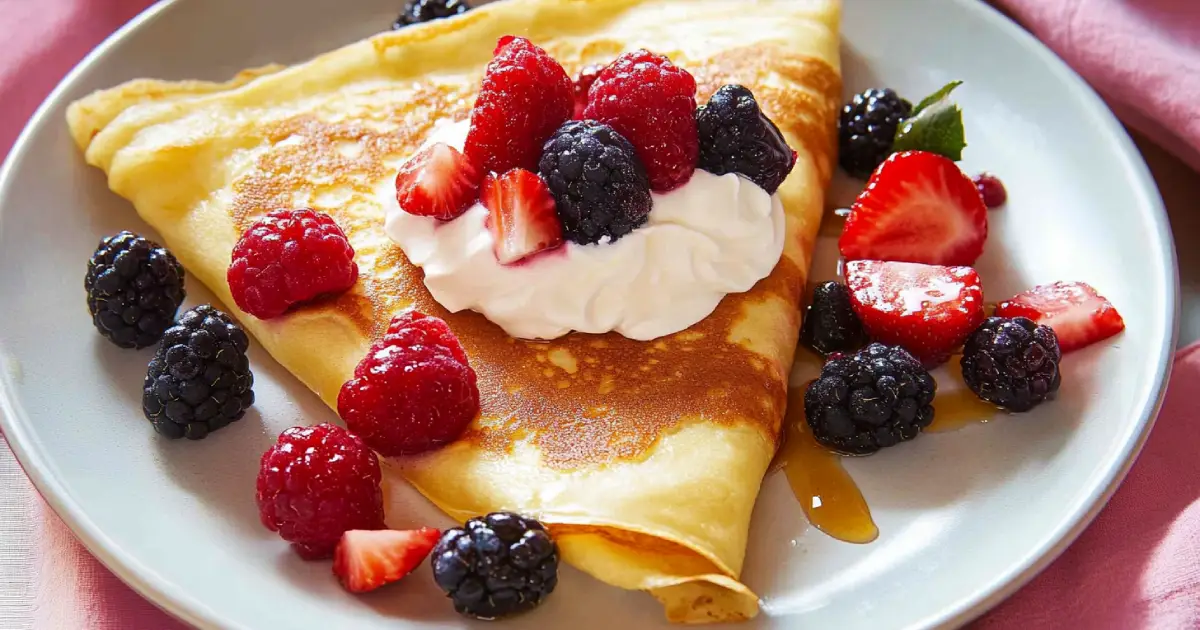Introduction: Why Dessert Crêpes Are a Must-Try
Let’s be real—dessert crêpes are the kind of treat that makes you feel fancy without actually requiring fancy skills. They’re thin, buttery, and just waiting to be filled with something sweet and delicious. Whether you’re loading them up with Nutella and strawberries or keeping it classic with a sprinkle of sugar and a squeeze of lemon, there’s no wrong way to enjoy them.
Crêpes may have a French name, but don’t let that intimidate you. The truth? They’re way easier to make than you think. With just a few basic ingredients—flour, eggs, milk, and butter—you can whip up a batch in no time. Plus, they’re incredibly versatile, which means you can dress them up for a special occasion or keep things simple for a quick, sweet fix.
So, if you’ve ever thought homemade crêpes were too tricky, I’m here to change your mind. Let’s break it down step by step, so you can make perfect dessert crêpes right in your own kitchen!
Table of Contents
1. What Makes a Perfect Dessert Crêpe?
Alright, let’s talk about what separates a so-so crêpe from a next-level, “wow-this-is-better-than-a-French-café” crêpe. The magic is all in the texture—thin, soft, and just the right amount of buttery crisp on the edges. But getting there? That’s where a few key tricks come in.
It’s All About the Batter
The heart of a perfect crêpe is the batter. It should be smooth, thin, and free of lumps. If it’s too thick, you’ll end up with something closer to a pancake. Too runny? It’ll be a nightmare to flip. The goal? A silky, pourable consistency, kind of like heavy cream.
Resting the Batter = Better Crêpes
Here’s a step people love to skip, but trust me—it makes a difference. Letting the batter rest for at least 30 minutes (or even overnight in the fridge) gives the flour time to fully absorb the liquid. This results in softer, more flexible crêpes that don’t tear when you fold or roll them.
The Right Pan Makes a Difference
You don’t need a fancy crêpe pan (though if you have one, go for it). A good non-stick pan does the job just fine. The key is using a pan with a flat surface and slightly sloped sides, so flipping is a breeze.
Even Cooking for That Golden Perfection
A good crêpe should cook evenly without burning or sticking. To get that, keep your pan at medium heat and lightly coat it with butter or oil before pouring in the batter. And remember—crêpes cook fast! Once you see the edges lift slightly, it’s time to flip.
Master these basics, and you’re already halfway to crêpe perfection. Next up? Let’s break down the ingredients that make it all happen!
Enjoy the sweet and nutty goodness of this Pecan Rolls Recipe from Peppery Recipes!
Essential Ingredients for the Best Dessert Crêpes
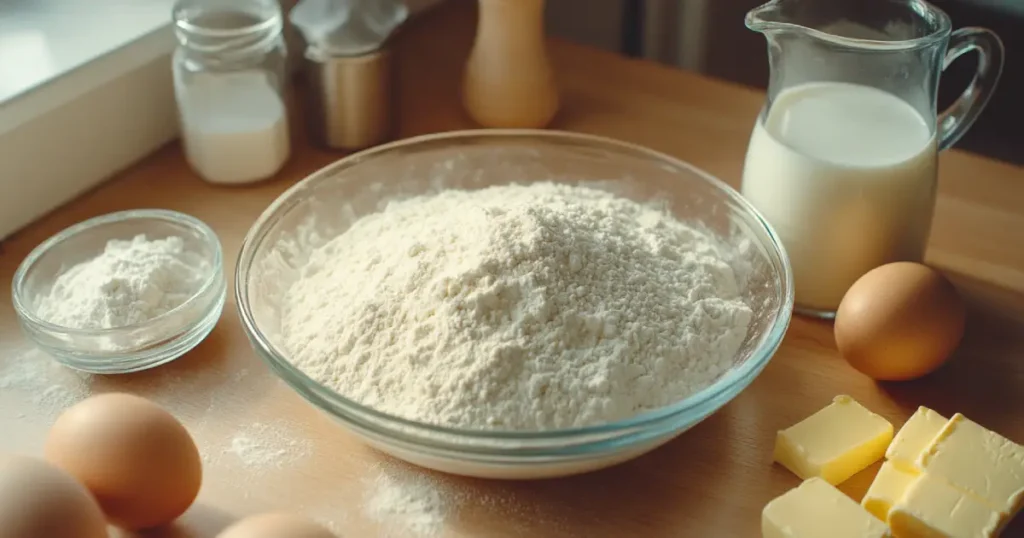
You don’t need anything fancy to whip up a batch of perfect dessert crêpes. In fact, you probably have everything in your kitchen right now. The trick is knowing why each ingredient matters—and how small tweaks can change the final result.
Flour: The Foundation of the Batter
All-purpose flour is the go-to for crêpes because it gives them just the right balance of structure and softness. If you want an even lighter texture, you can swap in cake flour, but honestly, regular flour works just fine.
Eggs: The Secret to a Smooth, Flexible Crêpe
Eggs hold everything together and help create that slightly elastic texture that makes crêpes easy to roll and fold. Skip them, and you’ll end up with something closer to a pancake that cracks instead of bending.
Milk: The Key to a Thin, Pourable Batter
Milk makes the batter smooth and easy to spread in the pan. Whole milk is best for richness, but if you only have 2% or even a mix of milk and water, that works too. Just avoid using only water—it won’t give you that soft, slightly chewy bite.
Butter: For That Buttery, Golden Goodness
Melted butter in the batter adds flavor and helps keep the crêpes from sticking to the pan. Plus, it gives them that subtle richness that makes them taste amazing even before you add any fillings.
Sugar & Vanilla: Just a Touch of Sweetness
Dessert crêpes don’t need much sugar in the batter—just a tablespoon or two to give them a light sweetness. Vanilla extract adds a little extra flavor, making every bite taste more like a treat.
Bonus Flavor Boosters (Optional but Delicious)
- A splash of rum or Grand Marnier – A little boozy kick makes crêpes taste extra fancy.
- Orange zest or lemon zest – Adds a subtle citrus aroma that pairs well with fruity fillings.
- Cinnamon or nutmeg – A pinch of warm spice can give your crêpes a cozy, dessert-like flavor.
With these simple ingredients, you’re on your way to making soft, golden crêpes that taste just as good plain as they do stuffed with Nutella and fruit. Now, let’s talk about how to actually make them, step by step!
Step-by-Step: How to Make Dessert Crêpes Like a Pro
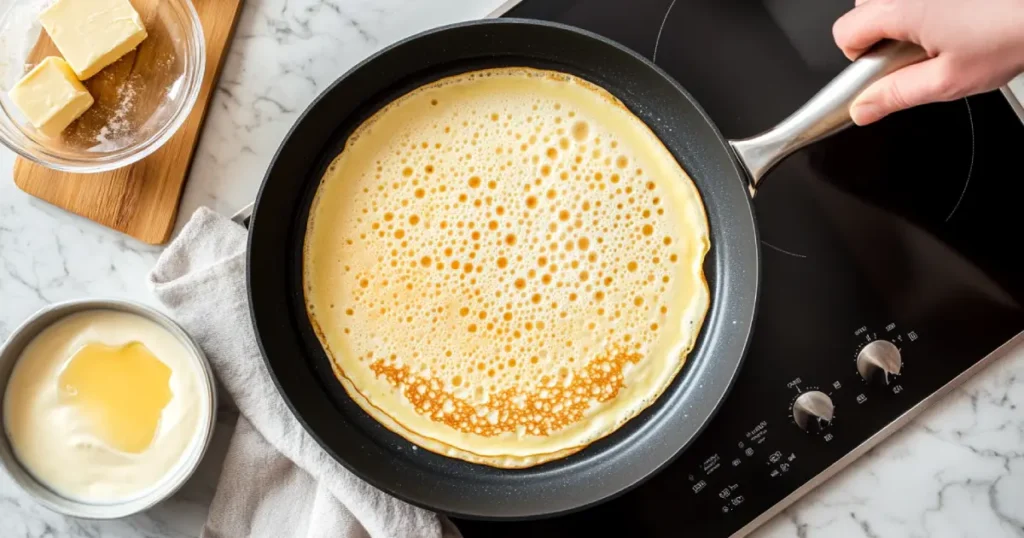
Now that you’ve got your ingredients ready, it’s time to bring everything together. Making crêpes is way easier than it looks, and once you get the hang of it, you’ll be flipping them like a pro. Let’s go step by step to make sure every crêpe turns out soft, golden, and perfect.
Step 1: Mix the Batter Until It’s Silky Smoot
Start by whisking your eggs in a large bowl. Then, add the flour, sugar, and a pinch of salt. Slowly pour in the milk while whisking constantly. The goal here is to prevent lumps—nobody wants a chunky crêpe.
Once everything is combined, stir in the melted butter and vanilla extract. If you really want the smoothest batter possible, run it through a fine-mesh strainer or give it a quick blend with an immersion blender.
Step 2: Let the Batter Rest (Seriously, Don’t Skip This!)
This is the hardest part—waiting! But letting the batter rest for at least 30 minutes (or even overnight in the fridge) makes a huge difference. It helps the flour absorb the liquid, which leads to softer, more flexible crêpes. If you’re in a rush, you can use it right away, but trust me, the wait is worth it.
Step 3: Heat Your Pan & Get It Ready for Cooking
A non-stick skillet or crêpe pan is your best friend here. Heat it over medium heat and lightly coat it with butter or oil. You don’t want too much—just enough to prevent sticking. If you add too much butter, your first crêpe might turn out a little crispy (which, honestly, isn’t the worst thing).
Step 4: Pour & Swirl the Batter
Here’s where the magic happens. Pour about ¼ cup of batter into the center of the pan, then immediately lift the pan and swirl it in a circular motion so the batter spreads out into a thin, even layer. If you don’t swirl fast enough, you’ll end up with thick spots—so move quickly!
Step 5: Cook Until the Edges Lift, Then Flip
Let the crêpe cook for about 60-90 seconds. You’ll know it’s ready to flip when:
✔️ The edges start to lift slightly from the pan.
✔️ The bottom is golden brown.
✔️ The surface looks set (not wet or raw).
Use a spatula to gently loosen the edges, then flip it over. The second side only needs 30 seconds to cook—just long enough to get a light golden color.
Step 6: Stack & Keep Warm
As you cook, stack your crêpes on a plate and cover them with a clean kitchen towel to keep them warm. They’ll stay soft and flexible, making them easy to fill and fold later.
The Best Sweet Fillings & Toppings for Dessert Crêpes
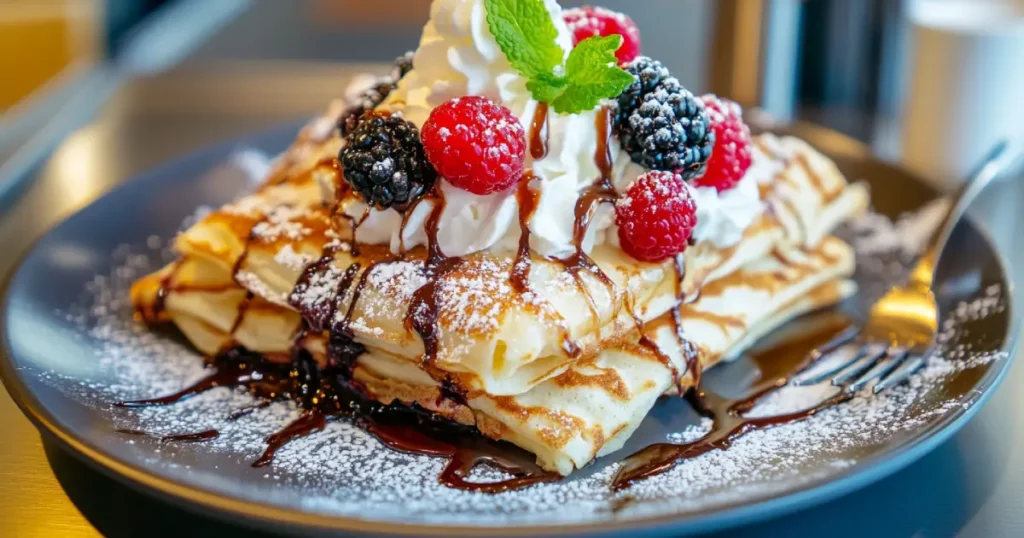
Alright, now for the fun part—what to put inside (and on top of) these golden beauties! The best thing about dessert crêpes? You can go as simple or as fancy as you want. Whether you’re in the mood for classic flavors or something totally indulgent, there’s a perfect combo for everyone.
Classic & Timeless Fillings
Sometimes, the simplest flavors are the best. These options never fail:
- Sugar & Lemon Juice – A French classic. Just sprinkle granulated sugar over a warm crêpe and squeeze fresh lemon juice on top.
- Butter & Cinnamon Sugar – Melted butter with a dusting of cinnamon sugar makes for an easy but irresistible treat.
- Strawberry Jam or Fruit Preserves – Sweet, fruity, and light—perfect if you love a no-fuss filling.
Chocolate Lover’s Dream
If you’re all about chocolate, these combos are pure magic:
- Nutella & Bananas – A legendary duo that needs no introduction.
- Dark Chocolate & Raspberries – Melted chocolate with tart raspberries? Yes, please.
- Peanut Butter & Chocolate Chips – A little salty, a little sweet, and totally addictive.
- Cookies & Cream – Crushed Oreos with whipped cream or vanilla ice cream inside.
Creamy & Decadent Fillings
For crêpes that feel extra fancy, try these rich, creamy combos:
- Mascarpone & Honey – Light, creamy mascarpone cheese with a drizzle of honey.
- Ricotta & Lemon Zest – A little tangy, a little sweet, and totally delicious.
- Whipped Cream & Berries – Classic, simple, and always a hit.
- Pastry Cream & Caramelized Bananas – Think banana cream pie, but in crêpe form.
Fancy French-Inspired Creations
Want to impress? These elegant options will do the trick:
- Crêpes Suzette – A classic French dessert with a buttery orange sauce and a splash of Grand Marnier.
- Chestnut Cream & Whipped Cream – A very French flavor that’s perfect for fall and winter.
- Dark Chocolate Ganache & Almonds – Rich, smooth, and nutty.
Toppings That Take It to the Next Level
No crêpe is complete without a little something extra on top! Here are some must-try finishing touches:
- Powdered Sugar – A light dusting makes everything prettier.
- Chocolate or Caramel Drizzle – Because more chocolate is never a bad idea.
- Fresh Fruit – Strawberries, blueberries, bananas, raspberries—pick your favorite!
- Whipped Cream – Always a good choice.
- Crushed Nuts – Toasted almonds, pecans, or hazelnuts add a great crunch.
- Ice Cream – Vanilla, chocolate, or even salted caramel for an over-the-top treat.
Tips & Tricks for Flawless Crêpes Every Time
Alright, you’ve got the batter, the technique, and the fillings down. But let’s be real—crêpes can be a little tricky at first. If your first one turns out weird, don’t stress (it happens to everyone!). Here are some simple tricks to make sure every crêpe is soft, golden, and perfect.
1. Use the Right Pan
A non-stick skillet or a crêpe pan is your best friend. If the pan isn’t non-stick, you’ll have a flipping disaster on your hands. A 9- to 10-inch pan is ideal for easy swirling and flipping.
2. Get the Batter to the Right Consistency
Your batter should be as thin as heavy cream—pourable but not watery. If it’s too thick, add a splash of milk. If it’s too thin, mix in a tiny bit more flour.
3. Rest the Batter for Better Texture
I know, I know—waiting is hard. But letting the batter rest for at least 30 minutes (or overnight in the fridge) makes a big difference. It gives the flour time to absorb the liquid, which makes the crêpes softer and more flexible.
4. Heat the Pan to the Right Temperature
Medium heat is your sweet spot. If the pan is too hot, your crêpes will burn before they cook through. Too cool? They’ll be pale and rubbery. A good test: sprinkle a few drops of water on the pan—if they sizzle and disappear, it’s ready.
5. Use Just Enough Butter or Oil
You want a light coating of butter or oil—too much, and your crêpes will fry instead of cook evenly. A paper towel dipped in melted butter is a great way to grease the pan without overdoing it.
6. Pour & Swirl Like a Pro
Pour about ¼ cup of batter into the pan, then quickly lift and tilt the pan in a circular motion to spread it evenly. Move fast—once the batter starts cooking, it won’t spread anymore!
7. Flip Gently but Confidently
Once the edges start to lift and the bottom is golden, it’s time to flip. Use a spatula to gently loosen the crêpe, then either:
✔️ Use the spatula to carefully flip it over.
✔️ Use your fingers (if you’re feeling brave) to lift the edge and turn it.
Don’t be afraid—crêpes are thin but stronger than they look!
8. Keep Crêpes Warm Without Drying Them Out
Stack cooked crêpes on a plate and cover them with a clean kitchen towel to keep them soft and warm. If you need to reheat them, a quick 10-second zap in the microwave does the trick.
9. Don’t Worry About the First One
The first crêpe is always a little wonky—it might be too thick, too pale, or just not pretty. It’s totally normal! Think of it as a test run to get the pan temperature right.
10. Freeze Extras for Quick Desserts
Crêpes freeze beautifully! Stack them with parchment paper in between, place them in a freezer bag, and freeze for up to 2 months. When you’re ready to eat, just warm them in a pan or microwave.
Fun Ways to Serve Dessert Crêpes
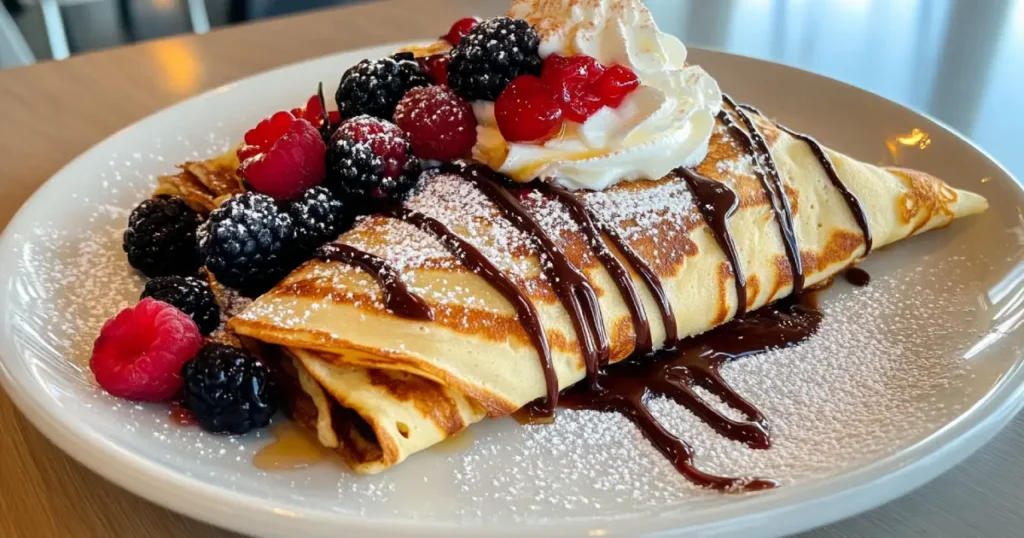
Crêpes aren’t just delicious—they’re also one of the most fun desserts to serve. Whether you’re making them for a cozy brunch, a fancy dinner party, or just a late-night treat, a little creativity can make them feel extra special. Here are some fun ways to serve dessert crêpes that’ll impress your guests (or just make your own plate look Instagram-worthy!).
1. Rolled Crêpes: The Classic French Café Style
Rolling crêpes keeps all the filling inside and makes them easy to eat. Just spread your favorite filling (Nutella, jam, or whipped cream work great), roll them up like a thin burrito, and top with powdered sugar or a drizzle of sauce.
2. Folded Triangle Crêpes: Simple & Elegant
This is the easiest way to serve crêpes while still making them look fancy. Spread your filling, fold the crêpe in half, then fold again into a triangle. This method works great for thinner fillings that don’t need a lot of space.
✔️ Best for: Lemon & sugar, chocolate drizzle, or caramel sauce
✔️ Perfect for: A classy brunch or a light dessert
3. Stacked Crêpes: The Ultimate Crêpe Cake
Why have just one crêpe when you can stack them into a whole cake? Layer crêpes with whipped cream, pastry cream, or chocolate ganache in between, and keep stacking until you have a tall, dreamy crêpe cake. Dust with powdered sugar or cocoa powder on top for a final touch.
✔️ Best for: Special occasions or birthdays
✔️ Perfect for: Impressing guests with minimal effort
4. Ice Cream Crêpes: A Sundae, but Better
Warm crêpes + cold ice cream = pure heaven. Just fold or roll a crêpe, place a scoop of ice cream on top, and drizzle with chocolate or caramel sauce. Add crushed nuts or whipped cream for extra crunch and creaminess.
✔️ Best for: Hot summer days or when you want a quick but fancy dessert
✔️ Perfect for: Vanilla, chocolate, or salted caramel ice cream
5. Caramelized Crêpes: Slightly Crispy, Super Flavorful
For a next-level treat, sprinkle a little sugar on top of your crêpe and use a kitchen torch to caramelize it, just like a crème brûlée. It creates a crispy, golden sugar topping that cracks when you bite into it.
✔️ Best for: Special occasions when you want to impress
✔️ Perfect for: Crêpes Suzette or any citrus-flavored filling
6. DIY Crêpe Bar: Let Everyone Customize Their Own
Hosting a brunch or dessert night? Set up a DIY crêpe bar with different fillings and toppings so everyone can make their own creation. Put out bowls of Nutella, fresh fruit, whipped cream, caramel sauce, and whatever else you love.
✔️ Best for: Family gatherings, brunches, or dinner parties
✔️ Perfect for: Making sure everyone gets exactly what they want
FAQs about Crepes
Which country invented crepes?
→ Crepes were invented in France, specifically in the Brittany (Bretagne) region. They have been a traditional dish there for centuries.
What is the name of the thing to make crepes?
→ The main tool for making crepes is called a crepe pan or a crepe maker. In France, a crêpière (flat griddle) is commonly used, especially for making thin and even crepes. To spread the batter evenly, a T-shaped wooden spreader called a “rozell” is often used.
Why crepes Suzette?
Crepes Suzette is a famous French dessert featuring crepes flambéed with orange sauce, butter, sugar, and Grand Marnier (or another orange liqueur).
The dish is said to have been created by accident when Auguste Escoffier (a renowned French chef) was serving crepes to the future King Edward VII of England. The story goes that the prince liked the dish so much that Escoffier named it after Suzette, a young lady at the table.
How do I make my crepes not dry?
Here are some tips to keep your crepes soft and moist:
Add a little more fat (melted butter or oil) to the batter for a more tender texture.
Let the batter rest for at least 30 minutes before cooking; this allows the flour to absorb the liquid and results in softer crepes.
Use the right heat: Medium heat is best—too high will make them dry and crispy.
Cover the crepes with a clean kitchen towel after cooking to retain moisture.
Brush the pan lightly with butter between batches to keep the crepes from sticking and drying out.
Use milk or even a little cream in the batter to keep them tender.
Conclusion: Time to Get Cooking!
And there you have it—everything you need to make the perfect dessert crêpes! From mixing up a silky-smooth batter to flipping like a pro and loading them up with delicious fillings, you’re now officially ready to bring a little French café magic into your own kitchen.
The best part? Crêpes are super forgiving. Even if your first one looks a little wonky (which, let’s be honest, it probably will), just keep going—by the second or third, you’ll have it down. Plus, no one’s complaining about an “ugly” crêpe when it’s filled with Nutella and strawberries.
So, whether you’re making a quick late-night treat, impressing guests with a crêpe bar, or stacking them into a dreamy dessert, just have fun with it. The possibilities are endless, and the results? Always delicious.

